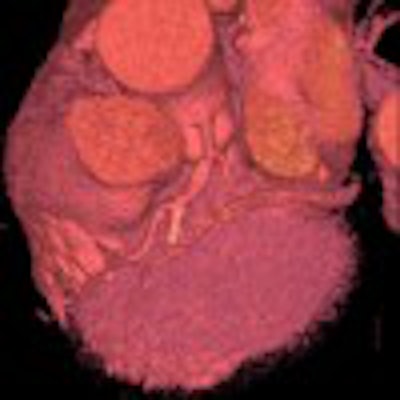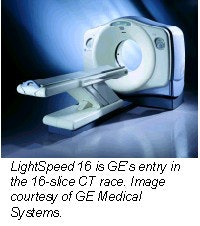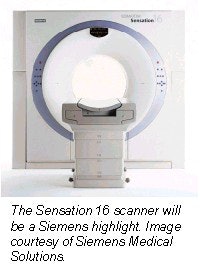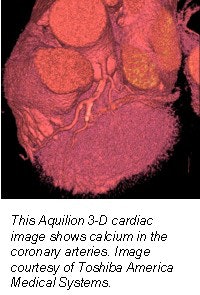
CT continues to ride a remarkable wave of growth and technical innovation as vendors push the envelope of multislice technology. This year saw the introduction of new 16-slice systems from three major vendors, all of whom say they’ll continue to push the envelope. Could 128-slice scanners and cone-beam reconstruction be around the corner?
The multislice revolution is spurring the development of a wide range of new applications for CT. Whole-body screening has become technically and economically feasible -- to the chagrin of organized radiology, which must grapple with the many ethical and socioeconomic issues associated with the screening of asymptomatic individuals.
Cardiac imaging with CT gets faster and better with each new generation of scanners. New CAD techniques, and virtual colonoscopy's demonstrated ability to detect clinically significant polyps, are transforming VC into a viable alternative to conventional colonoscopy. RSNA attendees will even see a few presentations on CT breast imaging at this year’s meeting.
Fusion imaging, particularly with hybrid PET/CT scanners, will be a major highlight on both the technical exhibit floor and in the scientific presentations. Clinical users have begun reporting positive experiences with the machines, which combine functional and anatomical modalities into a whole image that is greater than the sum of its parts, according to proponents. Look for the multislice explosion to confer clinical benefits in this area as well.
But all wasn’t rosy for CT in 2002. Concerns persist about the additional radiation dose delivered by multislice scanning, and a backlash is forming against the aggressive tactics of some whole-body screening entrepreneurs. And, as always, MRI looms in the shadows, ready to take whatever applications it can get from its sibling modality.
GE Medical Systems
Booth #4129
LightSpeed 16 is GE’s soldier in the 16-slice CT wars. The system is capable of true 16-slice acquisition in all scan modes and at all scan speeds, with sub-millimeter resolution down to 0.625 mm, according to the firm. Ultra-thin volumetric acquisition capable on the system improves visualization of small tortuous vessels, fine bony structures, and coronary arteries. LightSpeed 16 has FDA clearance and is shipping commercially, according to the Waukesha, WI, company.

GE will also show some of the first fruits of its acquisition of electron beam tomography vendor Imatron in December 2001. The e-Speed scanner is the first new EBCT system to emerge from GE Imatron since the deal was consummated.
e-Speed has a completely new system design, with a new power source for smoother, higher resolution, a new multislice detector system, and a new data acquisition system. e-Speed has FDA clearance and will carry a list price of around $2.2 million.
HiSpeed QX/i and HiSpeed CT/e Dual are new mechanical scanners that GE introduced during 2002. Both systems use LightSpeed-class components, such as HiLight Matrix detectors and Performix x-ray tubes, but at a more budget-conscious price.
HiSpeed CT/e Dual will be at the entry level of GE’s multislice product line, with 1- or 1.5-second rotation times and slices as thin as 0.6 mm. HiSpeed QX/i is a four-slice scanner with a 0.7-second rotation time and 0.6-mm slice thickness. Both units have 510(k) clearance.
Philips Medical Systems
Booth #7150
AcQSIM CT EasyLoc is an option to Philips’ AcQSIM 85-cm radiation therapy planning system, which enables therapy localization directly on the CT console. The system is designed to improve department workflow where a radiation oncologist is required to confirm isocenter location for marking the patient’s treatment area, thus eliminating the need for a second CT simulation system. The system will be available in the U.S. and internationally in the first quarter of 2003, according to the Andover, MA, company.
Siemens Medical Solutions
Booth #1129
Siemens is adding a new segment to its line of multislice scanners with Somatom Sensation 10, a 10-slice system to be introduced at the conference.

Sensation 10 operates at a half-second rotation speed, thus collecting 20 slices of data per second at sub-millimeter resolution. It reconstructs images at a rate of six per second with virtually isotropic resolution, according to the Malvern, PA, vendor.
Clinical applications on the scanner include trauma studies, whole-body organ imaging, cardiac and coronary CT angiography, and neuroimaging. Sensation 10 also includes Siemens’ Workstream concept, which optimizes clinical workflow, and C.A.R.E. Dose, a dose-optimization protocol that can reduce radiation dose by 20%-56% by adjusting radiation dose to body thickness.
The first Sensation 10 was installed as a work-in-progress at the University of Kentucky in Louisville in October, and 510(k) clearance of the system is pending.
Also look for Siemens to talk up its flagship multislice scanner, Sensation 16, which was introduced at last year’s RSNA meeting.
Toshiba America Medical Systems
Booth #7729

Aquilion 16 is a 16-slice scanner that Toshiba formally introduced in the U.S. in September. The scanner features a 40-row quantum detector with half-second gantry revolutions, and is capable of acquiring 16 simultaneous slices of 0.5 mm, 1 mm, or 2 mm with each gantry revolution, for total z-axis coverage of 32 mm.
Clinical applications include trauma, cardiac, lung, pediatrics, and CT fluoroscopy. The system will sell for between $1.8 million and $2.2 million, depending on configuration, with U.S. and international shipments starting in the first quarter of 2003.
The Tustin, CA, company will also highlight Asteion Multi 60, Power Version, a version of the company’s mid-range Asteion line that features a 60-kW generator and 6.5 million-heat-unit x-ray tube. Clinical applications include CTA, cardiac, and whole-body scanning, and the system carries a list price between $740,000 to $1.3 million. The scanner is currently available.
On the cutting edge of CT, Toshiba will demonstrate its ongoing work on 256-row detectors. The detectors will be available for the Aquilion and Asteion Multi systems. Toshiba has not stated when the detectors will be commercially available.
By Brian CaseyAuntMinnie.com staff writer
November 18, 2002
Copyright © 2002 AuntMinnie.com




















